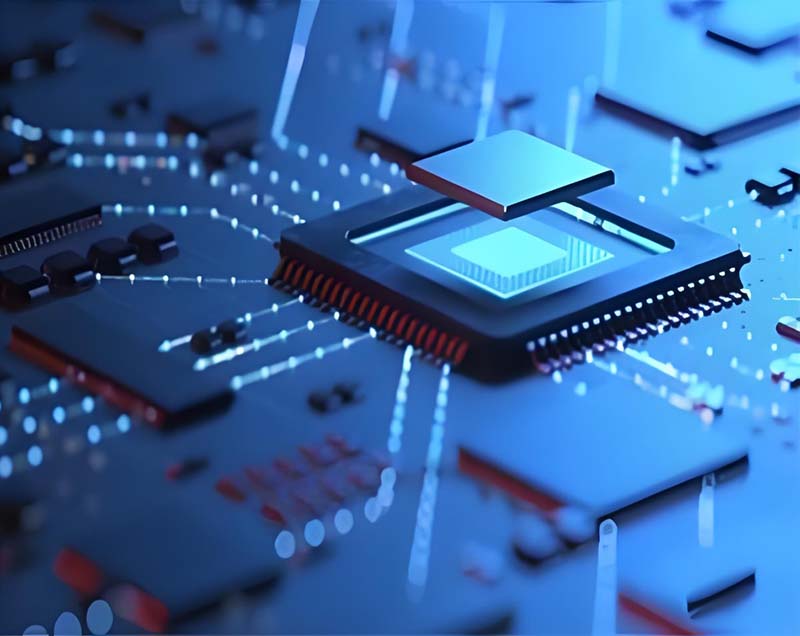Definition of PCB high frequency pcb boards
High frequency pcb boards are special circuit boards with higher electromagnetic frequency. Used in high-frequency (frequency greater than 300MHZ or wavelength of less than 1m) and microwave (frequency greater than 3GHZ or wavelength of less than 0.1m) PCB, is a microwave substrate laminate on the use of ordinary rigid circuit board manufacturing method of part of the process or the use of special processing methods of production of circuit boards. Generally speaking, high-frequency boards can be defined as boards with a frequency of 1 GHz or more. For general frequencies, FR-4 boards are sufficient, but for frequencies around 1-5G, high-frequency materials, such as semi-ceramic materials, should be used. More commonly used ROGERS 4350 series, 4003 series, 5880 series, etc.But if the frequency has been higher than 5G, it is best to use PTFE materials, that is, polytetrafluoroethylene, this material high-frequency performance is good, but there are limitations in the processing technology, such as can not be done to do the surface of the hot-air levelling process.
With the rapid development of science and technology,more and more equipment designed for microwave frequencyband (1GHZ) and even millimetre wave field (30GHZ) applications. This also means that the frequency is getting higher and higher, and the material requirements for the circuit boards are also getting higher and higher. For example, substrate materials need to have excellent electrical properties.Good chemical stability, and with the increase in power signal frequency in the substrate loss is very small, so the importance of high frequency pcb board is highlighted.
High frequency pcb board application areas
1.Mobile communication products
2.Power amplifiers. Low-noise amplifiers, etc.
3.Power dividers. Coupler. Duplexers. Passive components such as filters
4.Vehicle collision avoidance systems. Satellite systems Radio systems, etc. The high frequency of electronic equipment is the trend of development.

Classification of High Frequency Boards
1.Powdered Ceramic Filled Thermoset Materials
A. Manufacturers:
4350B/4003C from Rogers.
Arlon's 25N/25FR
Taconic's TLG series
B.Processing:
Processing is similar to epoxy resin/glass woven fabric (FR4), except that the sheet is more brittle and breaks easily. When drilling holes and causeways, the life span of drilling nozzles and causeways cutters is reduced by 20%.
PTFE (Polytetrafluoroethylene) Material
A. Manufacturers:
1. Rogers' RO3000 series, RT series, TMM series.
2. Arlon's AD/AR series, IsoClad series, CuClad series.
3. Taconic's RF Series, TLX Series, TLY Series
4.Taconic Microwave's F4B.F4BM.F4BK.TP-2
B.Processing method
1.Cutting: Must keep the protective film to prevent scratches and indentation.
2.Drilling:
2.1 Use brand-new drill (standard 130), one piece per stack is best, pressure foot pressure is 40psi.
2.2 Aluminium sheet as a cover plate, and then use 1mm miamine spacer to fasten the PTFE plate.
2.3 After drilling, use an air gun to blow out the dust in the hole.
2.4 Use the most stable drill and drilling parameters (basically, the smaller the hole, the faster the drilling speed, the smaller the chip load, the lower the return speed).
3.Hole treatment
Plasma treatment or sodium naphthalene activation treatment is favourable for air metallisation.
4.PTH copper immersion
4.1 After micro-etching (micro-etching rate is controlled at 20 micro inches), pull the plate in the PTH from the de-oiler.
4.2 If necessary, then after the second PTH, just start from the expected cylinder into the plate.
5.Solder Resist
5.1 Pre-treatment: Acid washing of the board, no mechanical grinding of the board.
5.2 Bake the boards after pre-treatment (90℃, 30min), brush with green oil for curing.
5.3 Bake in three sections: 80℃, 100℃ and 150℃ for 30mins each (if you find the substrate surface can be reworked: wash off the green oil and re-activate the treatment).
6.Causeway
The white paper will be paved on the line surface of PTFE board,and the top and bottom will be clamped with 1.0MM thickness of FR-4 substrate or phenolic base plate etched with copper.
The burrs on the back edge of the board need to be carefully trimmed by hand to prevent damage to the substrate and copper surface,then separated by a fairly sized piece of non-sulfur paper and visually inspected. The key to reduce the burrs is to have a good de-shawing effect during the process of Causeway Board.
Process Flow
1.NPTH's PTFE board processing flow
Opening - Drilling - Dry film - Inspection - Etching - Etching inspection - Solder resist - Character - Spraying - Forming - Testing - Final inspection - Packaging - Shipment.
2.PTH Teflon Sheet Processing Flow
Opening - drilling - hole treatment (plasma treatment or sodium naphthalene activation treatment) - copper immersion - plate electric - dry film - inspection - drawing electric - etching - etching - solder resist - character - tin spraying - moulding - testing - final inspection - packaging - shipment.
Conclusion:High Frequency PCB Board Processing Difficulties
1.Copper sinking: the hole wall is not easy to copper.
2.Pattern transfer.Etching.Line notch for line width.Sand hole control
3.Green oil process: green oil adhesion, green oil blistering control.
4.Strict control of surface scratches in each process.